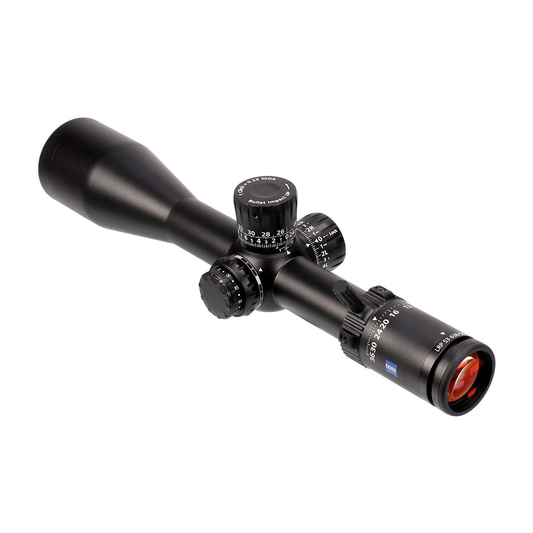

The Zeiss LRP S3 6-36x56 FFP Riflescope is designed to meet the highest standards of long-range shooters and precision marksmen. With its exceptional magnification range of 6x to 36x and a large 56mm objective lens, this riflescope offers unmatched clarity and detail for distant targets. The first focal plane reticle provides consistent reticle size relative to the target across the entire zoom spectrum, which is essential for precise holdovers and windage corrections at any magnification.
Engineered with Zeiss' industry-leading optics that include ED Glass and T* lens coating, the Zeiss LRP S3 ensures up to 90% light transmission, delivering sharp, high-contrast images even in challenging light conditions. The scope also features LotuTec coating, which repels water and dirt for clear visibility in any weather. The locking windage turret and ballistic stop of the elevation turret are designed for quick and reliable adjustments, while the external locking mechanism guarantees that your settings remain constant during the heat of action.
With illuminated reticle options in either ZF-MRi or ZF-MOAi #17, featuring red and green illumination suitable for daylight conditions, shooters can easily maintain a clear point of aim. The scope's parallax is adjustable from 10.9 yards to infinity, offering further precision for long-range shots. High-quality construction with a 34mm tube and a solid finish, the Zeiss LRP S3 6-36x56 FFP Riflescope is a robust and dependable choice for anyone serious about long-distance shooting.
Features
-
EXCEPTIONAL MAGNIFICATION: 6x to 36x magnification for precise targeting over long distances.
-
ILLUMINATED RETICLE: Daylight visible ZF-MOAi #17 reticle with red/green illumination and 5 intensity levels.
-
ADVANCED OPTICS: ED glass and T* coating for 90% light transmission, along with LotuTec coating for clear vision.
-
PRECISE ADJUSTMENTS: 0.25 MOA click adjustments with a total of 110 MOA elevation and a locking windage turret.
-
ROBUST CONSTRUCTION: Durable 34mm tube with a sleek black finish, capable of withstanding rigorous use.
-
DIOPTER RANGE: Generous +3 to -3 diopter adjustment allows for sharp reticle focus for individual eyesight.
-
FIRST FOCAL PLANE: Reticle size adjusts with magnification, maintaining the correct scale for range estimation.
-
PARALLAX FREE: Side parallax compensation from 10.9 yards to infinity, ensuring a parallax-free shot.
Specifications
| Feature | Specification |
|---|---|
| Scope Weight | 39.1 ounces |
| Scope Length | 15.1 inches |
| Magnification Range | 6x - 36x |
| Objective Diameter | 56mm |
| Tube Size/Mount | 34mm |
| Click Value | 0.25 MOA |
| Elevation Turret Details | Exposed, Ballistic Stop, 110 MOA total travel |
| Windage Turret Details | Exposed, External Locking, 50 MOA total travel |
| Parallax Adjustment | 10.9 yards to infinity |
| Reticle Position | First Focal Plane |
| Illuminated Reticle | Yes - 5 levels |
| Scope Finish | Black |
| Product Type | Riflescopes |
| UPC | 740035016217 |
| MPN | 522685-9917-090 |
Included In The Box
- Zeiss LRP S3 6-36x56 FFP Riflescope (522685-9917-090)
- Protective Lens Caps
- Cleaning Cloth
- User Manual
You May Also Like
Here’s some of our most similar products people are buying. Click to discover trending style.








